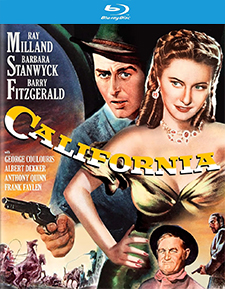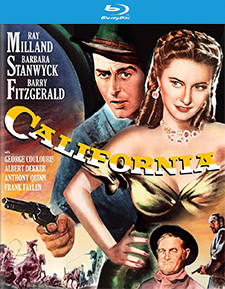California (1947) (Blu-ray Review)

Director
John FarrowRelease Date(s)
1947 (November 19, 2024)Studio(s)
Paramount Pictures (Kino Lorber Studio Classics)- Film/Program Grade: C
- Video Grade: B+
- Audio Grade: A-
- Extras Grade: F
Review
Though the list of 1940s Westerns include My Darling Clementine, Red River, The Ox-Bow Incident, Fort Apache, and She Wore a Yellow Ribbon, among others, the vast majority of A-picture ‘40s Westerns were much more along the lines of California (1947). In terms of output, B-Westerns starring people like Roy Rogers, William “Hopalong Cassidy” Boyd, Tim Holt and dozens more, dominated. Though generally targeting younger audiences and fiercely formulaic, the best B-Westerns are still enormous fun. When Hollywood’s big studios made the occasional A-Western, mostly they were little more than gussied-up Bs. Such is the case here. As Leonard Maltin, in his book generally remembered as TV Movies put it, California is “an elaborately ordinary Western.” Boy howdy.
That California is basically a $2 million B-Western is further evidenced by the name given the film’s heavy: Pharaoh Coffin. Even the more outrageous Hoppy films were less hokey.
The picture is extravagantly overdone from the start, with a Technicolor montage of an unspoiled, not-yet-settled California with multiple offscreen narration, all set to music by Victor Young and lyrics by E.Y. “Yip” Harburg. This segues to impressive location footage of an enormous wagon train with hundreds of costumed extras and at least 50 wagons, trailing off into the distance. Jonathan Trumbo (top-billed Ray Milland) is an army deserter now working as the wagon master. Stopping at a western town, saloon singer and professional gambler Lily Bishop (Barbara Stanwyck) is being run out of town. Friendly Irish immigrant farmer Fabian (Barry Fitzgerald) invites her to join the wagon train over Trumbo’s objections.
Gold fever overtakes the wagon train when news of the discovery at Sutter’s Mill reaches them. Lily leaves with ruffian Booth Pennock (a miscast Gavin Muir), who lashes Trumbo with his whip as they depart. All eventually converge on Pharaoh City, a wide-open town controlled by anti-statehood former slave trader Pharaoh Coffin (George Coulouris, wearing a hairpiece and menacing goatee). Lily uses her savings to buy a saloon which Trumbo wins from her in a card game, only to lose it just as quickly when Coffin and his enforcers, led by Pike (Albert Dekker), rough him up. Coffin, for his part, obsessively falls in love with Lily and she agrees to marry him, while Trumbo’s love-hate relationship seemingly goes nowhere; when they finally kiss in the closing seconds of the film it almost comes as a surprise. Meanwhile, aware of Coffin’s desire to make California his private kingdom, Trumbo champions Fabian to run against Coffin in the upcoming election.
Though Ray Milland appeared in a handful of other Westerns and even directed one, here he’s not convincing, sweat-soaked buckskins aside. Trumbo, possibly named after screenwriter Dalton Trumbo, a personal friend of director John Farrow, is petty and vindictive for most of the film, his romance with Lily more combative than passionate, and despite Farrow’s signature long tracking shot through the wagon train, not enough time is spent on this part of the story to establish Trumbo as a believable wagon master, either. Barbara Stanwyck, meanwhile, is too glammed-up to be believed, her ruby-red lips, rosy cheeks, and perfectly-coiffed hairstyles never mussed, even driving through the harsh and dusty California desert.
The supporting players come off better. Barry Fitzgerald enhanced even mediocrities like California, and he’s a delight in a somewhat atypical part (humble grape farmer), while George Coulouris, who tends to overplay broad stereotypes—his leading role in The Man Without a Body must be seen to be believed—adds interesting layers to his overwritten character, a ship’s captain in the slave trade, haunted by the sounds of the African men and women he carried into bondage. He’s better than the part deserves. Albert Dekker and Frank Faylen (as a pioneer allied with Trumbo) are also good.
Indeed, from a purely production values standpoint, California impresses. But the screenplay, credited to Frank Butler and Theodore Strauss, is hokier than most B-Westerns, and its loftier aspirations, as an epic about the Shangri-La-like countryside, seem silly. Butler was mostly a comedy writer, particularly associated with the Bob Hope-Bing Crosby Road movies; California, with modest tweaking, could have been a Hope vehicle along the lines of Son of Paleface.
Kino Lorber’s Blu-ray of California looks okay, not great. Filmed in three-color Technicolor, I noticed just one instance of matrix misalignment, but the 1.37:1 standard frame image seems like an older video transfer and while there’s nothing particularly wrong with it, the film just doesn’t “pop” with color and clarity like it should. The Region “A” encoded disc has better DTS-HD Master Audio (2.0 mono) with optional English subtitles. There are no extra features at all, not even a trailer, though Kino does include trailers for related titles available through their label.
As big studio escapist fare, California isn’t terrible, but it exemplifies exactly the kind of Western virtually extinct by the early 1950s, when filmmakers like Ford, Anthony Mann, Delmer Daves, Fred Zinnemann, Henry King and others redefined the genre.
- Stuart Galbraith IV

